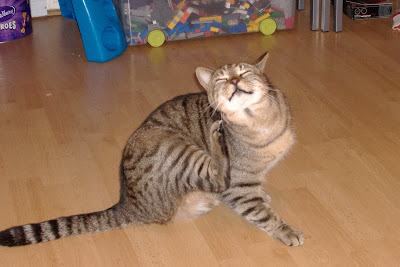
Basil's Baby" watercolor © Drew Strouble
http://www.catmandrew.com/
Hi Everyone.. I'm Drew Strouble
and here is one of my Cat Art Work .
...
...
...
Cat Joke... by ZoZo ( the cat )
What is a cat's way of keeping law & order? Claw Enforcement
Helpfull Article for Your Cat
( Feline Vaccinations )
Periodic vaccinations, or immunizations, are an important part of your cat's preventive health care plan.
Let's start by explaining what vaccination does for your cat.
In very simple terms, vaccination provides protection for your cat against the agent (usually a virus or bacteria) included in the vaccine. For instance, a rabies vaccine protects your cat against developing rabies.
To be more specific, vaccination (or immunization) is the act of introducing a virus, in an inactivated form, to your cat's immune system in an attempt to allow the immune system to develop protection (in the form of antibodies) against the virus in question before your cat is exposed to the naturally occurring, more dangerous virus.
There are several different types of vaccines which may be used.
A killed vaccine (KV) is a vaccine which contains a virus which is no longer "living". Your cat's immune system develops antibodies to the virus which provide protection against the disease caused by the virus, without the danger of your cat becoming ill. Once adequate numbers of antibodies have been formed and an adequate immune response is achieved, your cat will be safe in the event that he/she is exposed to the "living" form of the virus. Many rabies vaccines are killed vaccines.
A "modified-live" vaccine (MLV) is a vaccine which contains a virus which has been modified from its dangerous state so that it no longer causes disease. By introducing this "modified" virus to your cat, your cat's immune system is able to produce antibodies which protect him/her from the un-modified, disease-causing virus.
Other vaccine types utilize technologies such as recombinant DNA to produce immunity for your pet. These techniques render the disease agent to an inactive state which produces immunity when it is introduced to your cat's immune system.
In recent years, there has been some concern about potential vaccine reactions which has caused some changes in the way we vaccinate our animals today.
Currently, there are a group of "core" vaccines, which are vaccines which are required by all cats.
There is also a group of "non-core" vaccines which may or may not be necessary, depending on your cat's individual lifestyle and risk of exposure.
Which vaccines need to be given and how often they are given will vary from one cat to another. Your cat's veterinarian can help you decide which vaccines and what vaccination schedule is appropriate for your cat.
More Infos Click on... Cat Health Care Information -The Pet Med Site.
You Can Add this Article to Your Site if You Include the Bottom Line.
Rely on us for accurate, up-to-date
pet health care information.
-- A Simple Thought !
If You like this Site,Would it be a Good Idea to Bookmark it ?


















